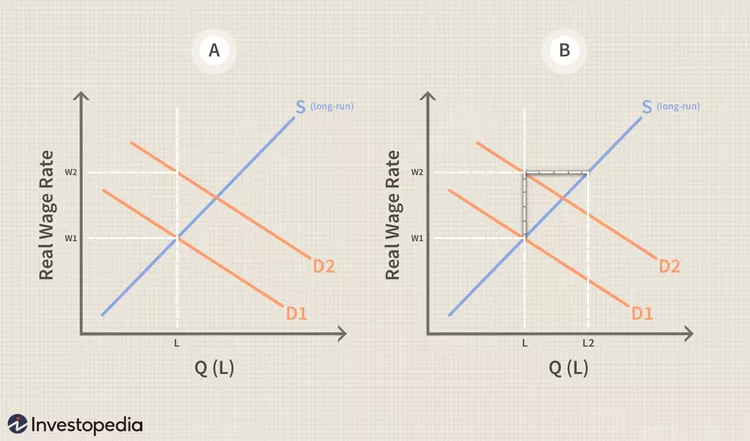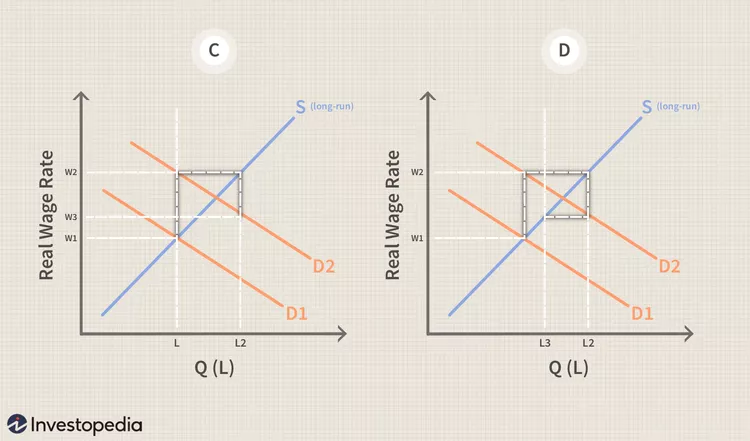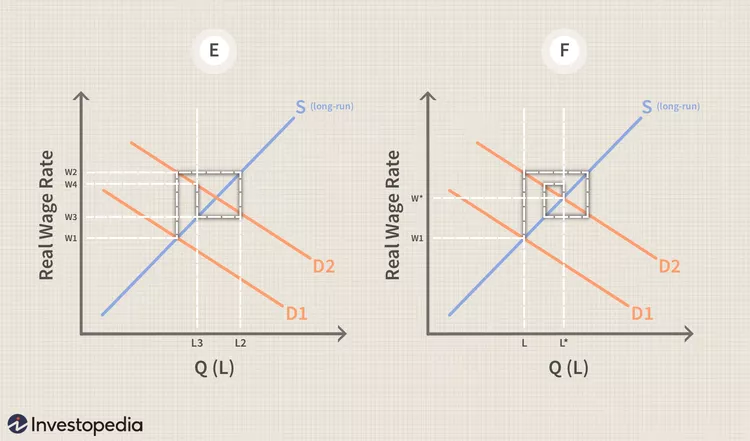Both have advantages and can reduce inequality.
What connection exists between a country's educational system and its economic output? Why do workers with college degrees typically make so much more money than those without? Understanding the relationship between education and training and the economy can help explain why some economies, firms, and workers prosper while others struggle.
The wage rate is under pressure to decline as the labor supply expands. Wages typically decrease if employers' demand for labor doesn't keep up with the labor supply.
People in fields with low entry barriers for new hires—those with positions that don't require a degree or any kind of specialized training—are severely harmed by an oversupply of workers. On the other hand, occupations that demand more formal education and training typically pay their employees more. Due to a shortage of workers qualified to work in certain areas and the high expense of the necessary education and training, wages have skyrocketed.
KEY LESSONS
- A major factor influencing both business and economic growth is the knowledge and skills of the labor force.
- Industries with more stringent educational and training requirements typically pay their employees more.
Training levels vary significantly across developed and developing nations, which is a crucial factor.
- The productivity of an economy increases as the number of educated people rises because competent workers can complete jobs more quickly.
- Equal educational and employment opportunities for people of all genders, races, ages, and ethnicities increase the value of an economy.
How Education Helps a Country
Countries and their economies must compete with one another in order to benefit from globalization and international trade. Although a single nation rarely specializes in a particular industry, economically successful countries will hold competitive and comparative advantages over other economies.
Various industries with varied competitive advantages and disadvantages in the global marketplace will be present in a typical developed economy. How well a country's economy will do depends in large part on how well-educated and trained its workforce is.
What Effects Job Training Has on the Economy
A strong economy has a labor force that can run its industries at a level that gives it an edge over the economies of other nations. Nations may attempt to encourage training through tax incentives, the provision of facilities for people to receive training or a variety of other strategies aimed at developing a more competent workforce. While it's doubtful that an economy will have a competitive advantage in every industry, it can concentrate on a few that can more easily train talented workers.
Training levels vary significantly across developed and developing nations, which is a crucial factor. Although there are undoubtedly other factors at play, such as geography and resource availability, having better-trained personnel has favorable externalities that spread throughout the economy.
The Senedd’s decisions affect almost all aspects of public life in Wales, from health to education to the economy and more.
— Bevan Foundation (@BevanFoundation) February 22, 2022
Do you want to know more about how it operates? Book your tickets for our new training session now 👉 https://t.co/SN9VT4tirY pic.twitter.com/HlOl1309qm
A well-trained workforce makes it possible for an externality to have a favorable impact on an economy. In other words, having a skilled labor pool from which to hire people is an external factor that benefits all businesses. The highly skilled workforce may occasionally be concentrated in a particular geographic area. Because of those talented workers, similar enterprises may end up congregating in the same area; Silicon Valley, California, for instance.
Employers only
Employers like employees that are productive and need less supervision. When selecting whether or not to provide staff training, employers must take into account a number of criteria, such as:
- Will the workers' productivity rise as a result of the training program?
- Will the rise in productivity make the cost of covering all or some of the training worthwhile?
- Will an employee quit their employer for a rival after completing training if their employer pays for it?
- Can the freshly trained employee demand a greater salary?
- Will the employee have more negotiating strength or influence to get a raise?
- Will the increases in productivity and profits be sufficient to offset any pay raises as well as the overall cost of the training program if pay increases are necessary as a result of the training?
Employers may come across workers that reject training. This might occur in union-dominated industries because greater job security may make it more challenging to acquire skilled workers or fire less skilled ones. However, unions may also bargain with companies to make sure that their members are more productive and well-trained, which lessens the possibility that jobs would be outsourced.
For Employees
By enhancing and growing their abilities and skills, workers can make more money. Their value to an employer increases as they gain more knowledge about the duties of a given job and a certain sector of the economy.
To compete for a greater salary, employees can seek to pick up new talents or sophisticated techniques. Typically, workers can anticipate a boost in pay, though it will typically be less than the employer's productivity gains. When determining whether to enroll in a training program, the worker must take into account a number of aspects, such as:
- How much additional production can they anticipate?
- Does the worker have to pay for the training program?
- Will the employee experience a pay increase that would justify the program's expense?
- What are the employment prospects for professionals in that industry with more training?
- Is there a substantial shortage of skilled workers in that field on the market?
- Employers may cover all or some of the costs associated with training, however, this is not always the case. Additionally, if the program is unpaid and the employee is unable to perform the same number of hours as before, they risk losing revenue.
The economy
A lot of nations now concentrate more emphasis on creating educational systems that can generate employees qualified to operate in emerging areas like science and technology. This is partially due to the fact that older industries in developed nations are now less likely to remain dominant in the industrial landscape due to their decreased competitiveness. A movement to raise the general level of education of the populace has also evolved, with a growing conviction that everyone has a right to education.
When economists talk about "education," they don't just mean college degrees for employees. Education is frequently divided into distinct levels:
- American kindergarten and primary schools
- Secondary education consists of middle, high, and preparatory schools.
- University, community colleges, and vocational schools are all postsecondary institutions.
- As the percentage of educated workers rises, a nation's economy becomes more productive because educated workers are better able to complete activities that call for reading and critical thought. A greater degree of knowledge does come with a price, though. A nation may offer simple literacy initiatives and still see economic growth without having to support a vast network of schools and universities.
Economic growth is more rapid in nations where more people attend and complete their education than in nations where the workforce is less educated. In order to boost economic performance, several nations fund primary and secondary education. In this way, investing in education is equivalent to investing in improved machinery or other physical assets.
The enrolment ratio—the proportion of secondary school-age children enrolled in school to the total number of secondary school-age children in the population—is higher in developed countries than in developing countries.
The enrolment ratio is a different measurement from figuring out how much money is spent on education as a share of gross domestic product (GDP), which doesn't always correlate well with the general level of education in a population. GDP is a measure of a country's production of goods and services. As a result, investing a significant share of GDP in education does not guarantee that its citizens are better educated.
The intellectual capacity of an employee can be viewed as a resource by firms. This resource can be utilized to produce goods and services for sale. A company can potentially generate more skilled employees it has on staff. A knowledge-based economy is one in which employers view education as a valuable asset.
Investing in education has an opportunity cost for the worker, just like any other choice. Less time working and earning money means more time in the classroom. However, when more education is needed to perform the duties of a job, employers will pay more wages. In other words, even though a worker's salary might be lower in the short term, once the training is over, wages will probably be greater.
Model Cobweb
The Cobweb Model explains the results of employees picking up new abilities. The model demonstrates both how the supply of workers changes over time and how wages fluctuate as people pick up new skills.
The model demonstrates that workers' short-term salaries increase when they pick up new skills. The supply of trained workers, however, rises as more workers acquire training over time and join the workforce in search of higher salaries. The end outcome is reduced salaries because there are too many people available. A decrease in the supply of workers results from fewer workers being interested in such jobs as salaries rise. More workers are trained as the cycle restarts, and their earnings are temporarily increased.
Changes in the demand for particular sorts of employees have both long- and short-term implications because training and education require time to complete. This change is illustrated by economists using a labor supply and demand cobweb model. The supply of labor is examined over the long term in the model below, but changes in demand and pay are seen as they approach a long-term equilibrium.

Figure 1 shows how demand and wage rates have changed recently.
The increased demand for better-trained workers raises wages above the equilibrium level in the short run (graph A). We can see the change in higher demand (D2) and the intersection with higher earnings (W2). The short-term labor curve, or L, also intersects W2 and D2, though.
The more inelastic short-run labor supply curve is when wages are increasing as opposed to the long-run labor supply curve (S) (L). Due to the small number of workers who have or are able to promptly train for the new skill set, the short-run curve is more inelastic. The supply of labor shifts right (L2) and travels along the long-run labor supply curve as more and more employees are trained (graph B) (S).

Figure 2: The impact of new hires on salary rates
There is downward pressure on the pay rate as more new workers become available, causing it to drop from W2 to W3 (graph C).

Figure 3 shows the creation of a new pay equilibrium.
Fewer workers are interested in training for the abilities that businesses want as a result of the declining wage rate. As a result, earnings improve (up to W4), though they do so in increasingly smaller amounts. When the initial upward movement in demand equals the long-term supply of labor, the cycle of pay rises and labor increases stops (graph F).
Race, Training, and Education
Education doesn't necessarily translate into increased salaries for all workers in the US. For instance, according to the Economic Policy Institute, there are large and widening wage discrepancies for Black workers, with Black males earning only 71 cents and Black women earning only 64 cents for every $1 earned by White men.
These discrepancies are apparent at all pay levels, from low to high, but are most pronounced in top-paying industries due to a shortage of Black workers in those occupations. The disparities continue to exist at all educational levels: Black workers with high school, college, and advanced degrees make just 81.7%, 77.5%, and 82.4% of what White workers with the same degree make, respectively.
Black workers with bachelor's degrees experience unemployment at a rate comparable to White workers without a college education.
The jobs that Black Americans typically hold, such as truck drivers, food service employees, and office clerks, are more likely to be impacted by the arrival of automation, making them more susceptible to job loss in the near future. The future for African Americans can be improved, according to a 2019 McKinsey & Company analysis that looked at these trends, by "changing education profiles to correspond with emerging sectors" and "engaging companies and public leaders in implementing reskilling initiatives."
Without such modifications, Without these and numerous other reforms, the long-standing, well-established, and widening racial income inequality between Whites and people of color threatens to limit consumption. According to a 2021 study by The Brookings Institute, if all people had the same opportunities, the US GDP would be $22.9 trillion larger.
Additionally, according to Citibank research from 2020, after the inequality gap is narrowed, the U.S. economy will be $5 trillion more valued in five years.
Why Is Education Valued Economically?
In addition to encouraging entrepreneurship and technological advancements, education frequently increases productivity and creativity. These all contribute to increased output and economic growth.
How Much More Money Do Educate People Make?
The median weekly salary for workers with professional or doctoral degrees was $1,893 in 2020, followed by $1,545 for those with master's degrees, $1,305 for bachelor's degrees, and $938 for associate's degrees, according to the U.S. Bureau of Labor Statistics (BLS). With median weekly wages of $619, workers without a high school diploma were at the bottom of the list.
Who Pays for Compulsory Workplace Training?
In most cases, if your employer requires you to participate in a training program, it will pay for your tuition. In some states, like California, it is a requirement that employers pay for all costs associated with employment.
Others, though, give the employer the final say.
Check your local state laws to see if paying for workplace training is required by your company is permitted. If so, check to see if mandated training and associated charges are included in your employment contract (if you have one) or the company's employee manual.
The conclusion
The knowledge and skills of the labor force make up a significant portion of what determines company and economic growth. Economies with a sizable pool of skilled labor, produced through both formal education and vocational training, are frequently able to take advantage of this by expanding higher-value sectors like high-tech manufacturing.
Through legislation and employment initiatives, nations must guarantee that all of their residents have access to the education and training that can advance individuals, businesses, and the economy as a whole.
SPONSORED
Trade digital assets and you might win up to $10,000.
Trading digital assets has become simpler. You can trade and store assets with the help of OKX, a top provider of financial services for digital assets, and benefit from top-notch security. Additionally, if you make a deposit of more than $50 through a cryptocurrency purchase or top-up within 30 days of registering, you might win a Mystery Box worth up to $10,000. Find out more and register to get your Mystery Box right away.
